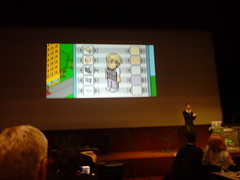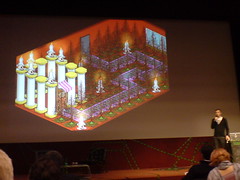LIFT07: Open-ended play in Habbo
 Open-ended play in Habbo Hotel, Sampo Karjalainen, Chief Creative Officer, Sulake
Open-ended play in Habbo Hotel, Sampo Karjalainen, Chief Creative Officer, Sulake
Talking about open-ended play in Habbo: thought of as a game, but it's goal-less, it's more of an open environment. Over 7m unique users in all the localised Hotels each month. Media age is 14 - it was designed for 13-16 yr olds. Japanese/Brazil users tend to be older. 51% girls, 49% boys.
There's the environment + a console (for in-world messaging), and in-game games. Traditional multiplayer stuff in teams, competing against other players: diving, snowball fights, etc.
What's making users come back? Users can create their own rooms and start furnishing them. They populate these rooms from a catalogue and there's a trading/collection mechanic in there too, with trading rooms etc. All kinds of activity rooms: running rooms, teleporters, etc. Users can set up quests in their rooms too.
There are adoption rooms, and "stables" where some players look after others. Traders trade items in ebay, there are fan sites ("Habbo Meadow"), and other mechanisms for supporting in-world activities. Habbo users can also make their own web pages very easily.
 They love to play like kids do. They're not kids any more, they're teenagers but in an online environment they can play together. It's not cool for kids of that age to say they play, so Habbo can't use that in their marketing, but they still love it.
They love to play like kids do. They're not kids any more, they're teenagers but in an online environment they can play together. It's not cool for kids of that age to say they play, so Habbo can't use that in their marketing, but they still love it.
Thoughts on doing this stuff:
- Avatars, lego, even the words and letters of chat, are all building blocks for playful interaction.
- If you let users move, rotate, colour, transform and stack items in the world, this supports play better than the simple interactions that occur in the browser environment.
- Keep the UI invisible: dialogs get in the way of the flow of play.
- Set up a mood for play. Try to minimise utilitarian for-profit thinking and "celebrate the fun of doing".
- Let players choose their own goals. High scores and rankings make things very one-dimensional.
- When you design for play, people will come up with all sorts of unexpected stuff: but you still need to get some sort of idea of what might happen.
- The bonus multiplier for this stuff is putting it into a shared social setting: this is when it gets interesting. It's difficult to build interesting play environments or toys for a single user, but easier in a social setting.
I wonder.... how does Habbo sustain itself commercially?
Q: How much do kids spend in the hotel?
A: A large chunk of users play for free. 10% pay for it, about 10 euros pcm.